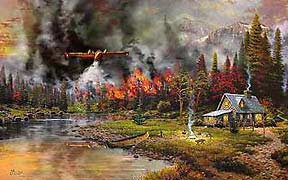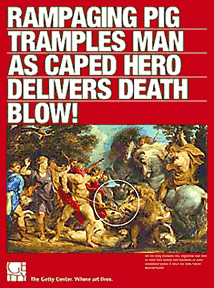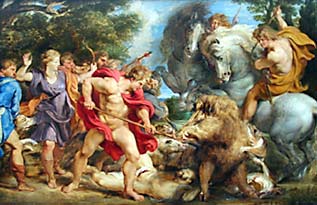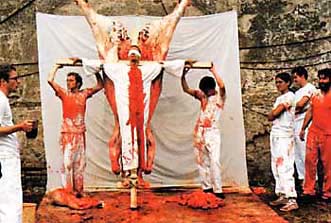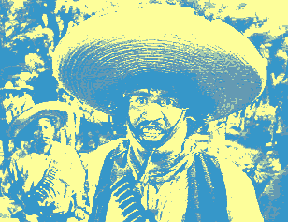[ On Sunday, August 06, 2006, we received an e-mail from abstract painter, Jack Chipman, who wrote: "Why is figurative painting, which is basically a skillful rendering of what the eyes can see, considered to be more valid than abstraction, which is dependent for its success on imagination and skillful manipulation of paint?" Our answer to Chipman's question follows ]Figurative vs. abstract painting is an old question, and one likely to be argued over forever, but don't roll your eyes just yet - readers might be surprised by the position of the LA Stuckists regarding this conflict of styles. First off, Chipman seems to be revealing a bias in his question when he states that figurative painting is basically a "skillful rendering of what the eyes can see", while abstract painting is "dependent for its success on imagination and skillful manipulation of paint." If it is so that figurative art is nothing more than what Chipman describes, then how does one explain the likes of figurative painters like
Philip Guston - one of the LA Stuckist group's heroes?
Guston displayed enormous amounts of imagination, and his paintings went far beyond "what the eyes can see." His figurative paintings were also dependent upon the "skillful manipulation of paint." The inference in Chipman's question is that figurative painters lack imagination while also displaying lackluster skills - an assertion that is patently ridiculous.
When Chipman asks why figurative painting is "considered to be more valid than abstraction", just who considers it to be of higher value? A cursory glance at any number of contemporary art museums around the world will reveal large, costly and extensive collections of abstract and non-figurative artworks. If anything, figurative painters with few exceptions have been complaining for decades about their works being overlooked or considered passé by museums and galleries. The LA Stuckist group respects skilled and original abstract artists and their works, because these days, when a
video tape showing someone vomiting is considered to be art, we'd prefer a day at MoMA gazing upon the Mark Rothko's -
thank you very much. That being said, the operational words here are "skilled" and "original." We insist that technical proficiency and imagination are necessary for good painting, but we find such expertise sorely lacking in today's artists - whether the artist prefers to work figuratively or abstractly. Merely proclaiming yourself to be a painter does
not make it so.
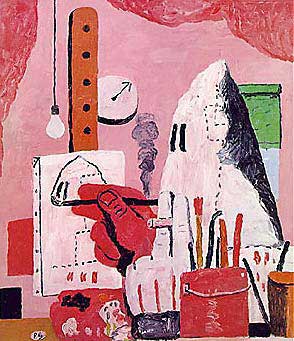
Painting by Philip Guston
Again, Philip Guston makes for a wonderful example. He was classically trained, and possessed tremendous expertise when it came to painting. He worked for the Works Progress Administration during the Great Depression, painting murals for government buildings. By the 1950's he had totally abandoned realism for abstract expressionism, but as severe and brutal as his abstractions were - one could always see a skilled visionary's hand at work. Guston reinvented himself once again in the late 1960's, turning away from abstract works in favor of a new figurative style. Nevertheless it was a blunt, provocative, and cartoon-like realism. Even though Guston's canvases had now almost become anti-paintings. you could still trace the hand of a master in it all. Guston's skill didn't come from out of nowhere, it came from decades of disciplined work and study. Who amongst today's wanna be painters can say as much?
But turning once more to the complicated and thorny question of figurative vs. abstract painting, let's examine one of the original debates. In 1949, New York's Museum of Modern Art presented a conference where the Social Realist painter, printmaker and muralist, Ben Shahn,
debated the abstract expressionist Robert Motherwell. Shahn defended figurative realism, while Motherwell argued for abstraction. Both artists were extremely articulate, but it's impossible to say who could actually win such a debate. What we know for a fact is that figurative realism fell out of favor, and Motherwell, along with fellow abstract artists Rothko, Pollock et al, came to dominate the artworld - even to this day.
Shahn painted realistic works that captured the time. His paintings of Sacco and Vanzetti, the union struggles of the 30's, the Great Depression and the Second World War, are world renowned masterworks. His painting style was not simply a skillful rendering of what the eye can see, it was an emotive and humanistic tour de force of unparalleled power.
But here's the question... what if Shahn's response to the world around him had been that of Motherwell. What if, instead of Shahn's clear narrative, recognizable subject matter, and appeal to shared values, we had in it's place Motherwell's absolute dearth of narrative, and nothing decipherable beyond amorphous shapes? What if, during the 1930's the prevailing style in art had been abstraction and Jacob Lawrence, Thomas Hart Benton, Stuart Davis, Rockwell Kent and all the other figurative artists of the time had not produced their realistic works? It would have been an incomparable loss and an impoverishment of our collective spirit. That is something to consider when pondering the situation of today's artworld - and the inherent value of figurative realism.
